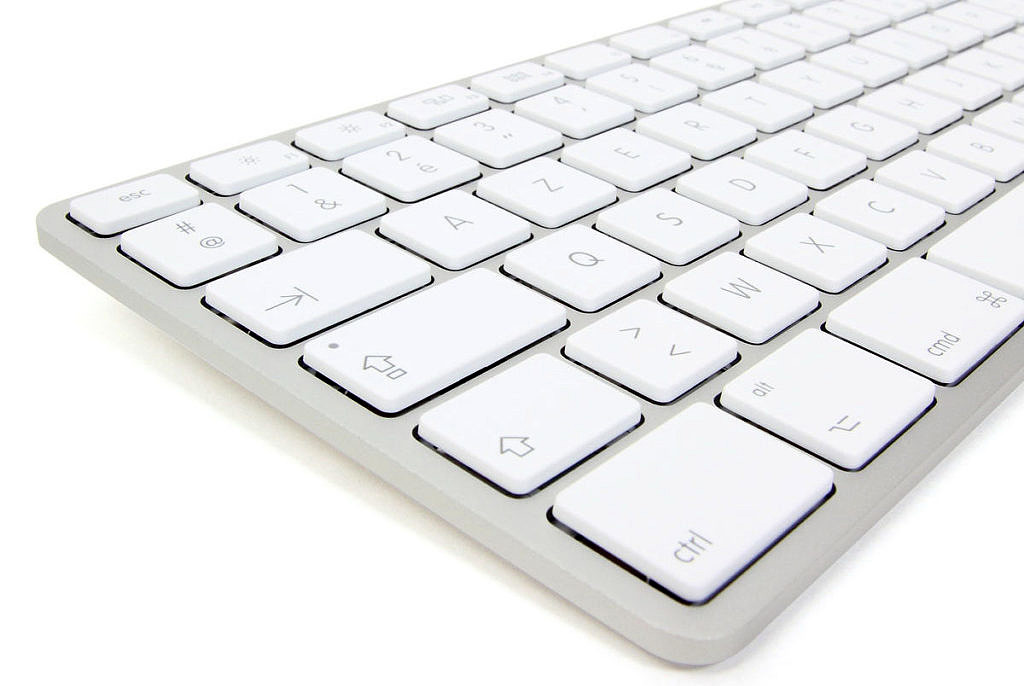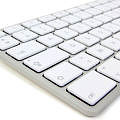Here is version 1.7 (Mac) of my Unicode keyboard “French AZERTY.” The Windows version is available here.
This keyboard extends the classical French AZERTY keyboard with numerous diacritics and symbols, which is useful for other latin-based languages (such as German, Polish, Hungarian, Esperanto…), typography, phonetics, and translitteration (including Indo-European and Semitic languages).
Installation
- Click on the following link to download my Mac keyboards: Claviers Michael Langlois (Mac).
- Double-click on the archive to open it. Then press the Control key and, while it is pressed, click once on the file named “Cliquez en appuyant sur la touche Control”. Release the Control key, then click “Open” on the contextual menu. A message asks you to confirm, click “Open”. Then, restart your computer.
- Go to > System Settings > Keyboard > Input Sources > Edit… Make sure the option “Show Input menu in menu bar” is checked, then click the “+” button (at the bottom left) to add one or more of my keyboards (since I have keyboards for French, Greek, Hebrew, Syriac…; they may appear in the “Others” category at the bottom of the list of languages).
Usage
- In your word processor (for instance TextEdit), place the cursor where you want to input text with this keyboard.
- Click on the menubar language icon, and choose my keyboard
- Once you’re done using this keyboard, click on the menubar language icon and choose “French.”
Functions
Alphabet
The alphabet and other common characters are located on the same keys as a regular French AZERTY keyboard.
Diacritics
Diacritics work in the same way as the circumflex accent on the French keyboard: type the accent, then the character that will receive it. Numerous diacritics are available; they are placed in a mnemotechnical way on a French keyboard:
Diacritics above
- circonflexe : touche ^ (ex: “^ i” → î)
- tréma : touche MAJ+^ (ex: “MAJ+^ i” → ï)
- aigu : touche é (ex: “é i” → í)
- grave : touche è (ex: “è i” → ì)
- macron : touche à (ex: “à i” → ī)
- brève : touche ù (ex: “ù i” → ĭ)
- tilde : touche ALT+é (ex: “ALT+é i” → ĩ)
- crochet : touche ALT+è (ex: “ALT+è i” → ỉ)
- caron : touche ALT+^ (ex: “ALT+^ i” → ǐ)
- rond : touche ALT+MAJ+@ (ex: “ALT+MAJ+@ a” → å)
- point : touche ALT+MAJ+; (ex: “ALT+MAJ+; t” → ṫ)
- double aigu : touche ALT+MAJ+é (ex: “ALT+MAJ+é u” → ű)
Diacritics below
- cédille : touche ç (ex: “ç t” → ţ)
- circonflexe souscrit : touche ALT+MAJ+^ (ex: “ALT+MAJ+^ t” → ṱ)
- brève (lunule) : touche ALT+ù (ex: “ALT+ù h” → ḫ)
- rond : touche ALT+@ (ex: “ALT+@ a” → ḁ)
- virgule : touche ALT+, (ex: “ALT+, t” → ț)
- point : touche ALT+; (ex: “ALT+; t” → ṭ)
- macron : touche ALT+: (ex: “ALT+: t” → ṯ)
- ogonek : touche ALT+ç (ex: “ALT+ç a” → ą)
Composite Characters
The Unicode system does feature all possible combinations.
Some fonts (notably Charis SIL) overcome this problem by offering smart diacritics positioning even when existing combination is lacking. It suffices to type the letter followed by the desired diacritical mark (pressing the SPACE key to place it below the preceding letter).
I can then add another diacritical mark in the same way.
Such a feature requires the use of a “smart” font such as Charis SIL and a compatible software (which should not be a problem on a recent computer).
Other characters
The keyboard additionally offers numerous characters used for transcriptions, critical editions, and so on.
Other dead keys
- lettres barrées : touche ALT+b (ex: “ALT+b o” → ø)
- petites majuscules : touche ALT+MAJ+m (ex: “ALT+MAJ+m t” → ᴛ)
- lettres gothiques : touche ALT+g (ex: “ALT+g MAJ+c” → ℭ)
- indices : touche ALT+n (ex: “ALTGR+n 1” → ₁)
- exposants : touche ALT+MAJ+n (ex: “ALTGR+n 1” → ¹)
Phonetics
- demi-anneau à droite (aleph) : touche ` (→ ʾ)
- demi-anneau à gauche (ayin) : touche MAJ+` (→ ʿ)
- coup de glotte : touche ALT+` (→ ʔ)
- coup de glotte réfléchi : touche ALT+MAJ+` (→ ʕ)
- epsilon latin (≠ grec) : touche ALT+& (→ ɛ) [pour la majuscule, combiner avec la touche MAJ]
- æ : touche ALT+a [idem]
- ej : touche ALT+z (→ ʒ) [idem]
- shwa : touche ALT+e (→ ə) [idem]
- thorn : touche ALT+t (→ þ) [idem]
- yogh : touche ALT+y (→ ȝ) [idem]
- œ : touche ALT+i [idem]
- o ouvert : touche ALT+o (→ ɔ) [idem]
- esh : touche ALT+s (→ ʃ) [idem]
- ed : touche ALT+d (→ ð) [idem]
- gamma latin (≠ grec) : touche ALT+g (→ ɣ) [idem]
- h barré : touche ALT+h (→ ħ) [idem]
- eszett : touche ALT+b (→ ß) [idem ; notez que c’est aussi une touche morte, il faut donc appuyer sur espace pour avoir le eszett]
- l sanglé : touche ALT+l (→ ɬ)
- j sans point : touche ALT+j (→ ȷ)
- i sans point : touche ALT+k (→ ı)
Symbols
- Diamètre (≈ ensemble vide minuscule) : touche ALT+q (→ ⌀)
- Ensemble vide (≈ diamètre majuscule) : touche ALT+MAJ+q (→ ∅)
- Multiplication : touche ALT+MAJ+$ (→ ×)
- Tiret insécable : touche ALT+à (→ ‑)
- Point de coupure de mot : touche ALT+§ (→ ‧)
- Prime : touche ALT+MAJ+’ (→ ′)
- Seconde : touche ALT+MAJ+” (→ ″)
- Crochet ouvert gauche : touche ALT+< (→ 〈)
- Crochet ouvert droit : touche ALT+MAJ+< (→ 〉)
- Demi-crochet haut gauche : touche ALT+MAJ+§ (→ ⸢)
- Demi-crochet haut droit : touche ALT+MAJ+à (→ ⸣)
- Demi-crochet bas gauche : touche ALT+MAJ+è (→ ⸤)
- Demi-crochet bas droit : touche ALT+MAJ+ç (→ ⸥)
- Cercle en pointillé : touche ALT+MAJ+! (→ ◌)
- Barres parallèles : touche ALT+MAJ+x (→ ∥)
- Version samaritaine : touche ALT+g $ (→ ⅏)
- Espace ponctuation : touche MAJ+espace
- Espace insécable : touche ALT+espace
- Espace sans chasse : touche ALT+MAJ+espace
- Point de conduite simple : touche ALT+p
If you have any suggestions to improve this keyboard, just let me know by leaving a comment below!
 En
En Fr
Fr

Merci, il va m’être très utile…Tu facilites d’un seul coup mes dures heures de traduction ^^
Merci, il va m’être très utile…Tu facilites d’un seul coup mes dures heures de traduction ^^
Merci! D’ailleurs je pourrais porter sur Mac mon clavier arabe, avec tous les diacritiques pour l’édition de manuscrits 😉
Michael Langlois ce serait juste génial si tu faisais ca !!!!!
Merci beaucoup pour ce clavier, il est vraiment très pratique. Une petite suggestion: ajouter la lettre hwair que l’on utilise pour transcrire le Gotique en alphabet latin; Ƕ (majuscule), ƕ (minuscule). A ma connaissance, elle n’est disponible sur aucun clavier.
Merci pour cet magnifique outil dont je fais un usage immodéré. j’aurais besoin (pour rendre des abréviations de manuscrits médiévaux) d’une sorte de p sanglé : comme le l sanglé, mais sur la hampe d’un p. Y aurait-il moyen de faire cela ?
Merci
CD
Bonjour et merci ! Je ne sais si ce caractère existe, mais je n’ai pas prévu de l’intégrer ; vous pouvez le cas échéant l’insérer grâce à la table des caractères. 😉